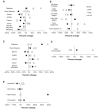An analytic approach for describing and prioritizing health inequalities at the local level in Canada: a descriptive study
- PMID: 27022600
- PMCID: PMC4701660
- DOI: 10.9778/cmajo.20150049
An analytic approach for describing and prioritizing health inequalities at the local level in Canada: a descriptive study
Abstract
Background: We present the health inequalities analytic approach used by the Saskatoon Health Region to examine health equity. Our aim was to develop a method that will enable health regions to prioritize action on health inequalities.
Methods: Data from admissions to hospital, physician billing, reportable diseases, vital statistics and childhood immunizations in the city of Saskatoon were analyzed for the years ranging from 1995 to 2011. Data were aggregated to the dissemination area level. The Pampalon deprivation index was used as the measure of socioeconomic status. We calculated annual rates per 1000 people for each outcome. Rate ratios, rate differences, area-level concentration curves and area-level concentration coefficients quantified inequality. An Inequalities Prioritization Matrix was developed to prioritize action for the outcomes showing the greatest inequality. The outcomes measured were cancer, intentional self-harm, chronic obstructive pulmonary disease, mental illness, heart disease, diabetes, injury, stroke, chlamydia, tuberculosis, gonorrhea, hepatitis C, high birth weight, low birth weight, teen abortion, teen pregnancy, infant mortality and all-cause mortality.
Results: According to the Inequalities Prioritization Matrix, injuries and chronic obstructive pulmonary disease were the first and second priorities, respectively, that needed to be addressed related to inequalities in admissions to hospital. For physician billing, mental disorders and diabetes were high-priority areas. Differences in teen pregnancy and all-cause mortality were the most unequal in the vital statistics data. For communicable diseases, hepatitis C was the highest priority.
Interpretation: Our findings show that health inequalities exist at the local level and that a method can be developed to prioritize action on these inequalities. Policies should consider health inequalities and adopt population-based and targeted actions to reduce inequalities.
Conflict of interest statement
Figures


Similar articles
-
CDC National Health Report: leading causes of morbidity and mortality and associated behavioral risk and protective factors--United States, 2005-2013.MMWR Suppl. 2014 Oct 31;63(4):3-27. MMWR Suppl. 2014. PMID: 25356673
-
[State of health of populations residing in geothermal areas of Tuscany].Epidemiol Prev. 2012 Sep-Oct;36(5 Suppl 1):1-104. Epidemiol Prev. 2012. PMID: 23139155 Italian.
-
[Inequalities in health in Italy].Epidemiol Prev. 2004 May-Jun;28(3 Suppl):i-ix, 1-161. Epidemiol Prev. 2004. PMID: 15537046 Italian.
-
Changing relative and absolute socioeconomic health inequalities in Ontario, Canada: A population-based cohort study of adult premature mortality, 1992 to 2017.PLoS One. 2020 Apr 2;15(4):e0230684. doi: 10.1371/journal.pone.0230684. eCollection 2020. PLoS One. 2020. PMID: 32240183 Free PMC article.
-
Health disparity by neighbourhood income.Can J Public Health. 2006 Nov-Dec;97(6):435-9. doi: 10.1007/BF03405223. Can J Public Health. 2006. PMID: 17203720 Free PMC article.
Cited by
-
The association of combinations of social factors and SARs-CoV-2 infection: A retrospective population-based cohort study in Ontario, 2020-2021.Dialogues Health. 2024 Oct 29;5:100197. doi: 10.1016/j.dialog.2024.100197. eCollection 2024 Dec. Dialogues Health. 2024. PMID: 39717675 Free PMC article.
-
Examining the association between area level deprivation and vehicle collisions that result in injury.Can J Public Health. 2018 Feb;109(1):43-51. doi: 10.17269/s41997-018-0036-7. Epub 2018 Feb 26. Can J Public Health. 2018. PMID: 29981062 Free PMC article.
-
Gendering Neighbourhood Marginalization Metrics in Mental Health Services Research: A Cross-Sectional Exploration of a Rural and Small Urban Population.Int J Environ Res Public Health. 2021 Oct 25;18(21):11197. doi: 10.3390/ijerph182111197. Int J Environ Res Public Health. 2021. PMID: 34769718 Free PMC article.
-
Socioeconomic gradients of adverse birth outcomes and related maternal factors in rural and urban Alberta, Canada: a concentration index approach.BMJ Open. 2020 Feb 2;10(1):e033296. doi: 10.1136/bmjopen-2019-033296. BMJ Open. 2020. PMID: 32014876 Free PMC article.
-
Measuring Health Equity for Ambulatory Care Sensitive Conditions in a Large Integrated Health Care System: The Development of an Index.Health Equity. 2019 Apr 3;3(1):92-98. doi: 10.1089/heq.2018.0092. eCollection 2019. Health Equity. 2019. PMID: 30963142 Free PMC article.
References
-
- Whitehead M, Dahlgren G. Concepts and principles in tackling social inequities in health: levelling up part 1. Geneva: World Health Organization; 2006.
-
- Reducing health disparities - roles of the health sector: discussion paper. Ottawa: Public Health Agency of Canada; 2005. pp. 1–43.
LinkOut - more resources
Full Text Sources
Other Literature Sources
